Kyeong Soo Kim
Mean Teacher based SSL Framework for Indoor Localization Using Wi-Fi RSSI Fingerprinting
Jul 18, 2024Abstract:Wi-Fi fingerprinting is widely applied for indoor localization due to the widespread availability of Wi-Fi devices. However, traditional methods are not ideal for multi-building and multi-floor environments due to the scalability issues. Therefore, more and more researchers have employed deep learning techniques to enable scalable indoor localization. This paper introduces a novel semi-supervised learning framework for neural networks based on wireless access point selection, noise injection, and Mean Teacher model, which leverages unlabeled fingerprints to enhance localization performance. The proposed framework can manage hybrid in/outsourcing and voluntarily contributed databases and continually expand the fingerprint database with newly submitted unlabeled fingerprints during service. The viability of the proposed framework was examined using two established deep-learning models with the UJIIndoorLoc database. The experimental results suggest that the proposed framework significantly improves localization performance compared to the supervised learning-based approach in terms of floor-level coordinate estimation using EvAAL metric. It shows enhancements up to 10.99% and 8.98% in the former scenario and 4.25% and 9.35% in the latter, respectively with additional studies highlight the importance of the essential components of the proposed framework.
Hierarchical Stage-Wise Training of Linked Deep Neural Networks for Multi-Building and Multi-Floor Indoor Localization Based on Wi-Fi RSSI Fingerprinting
Jul 18, 2024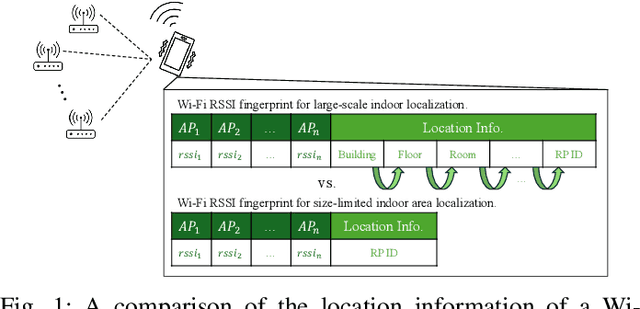
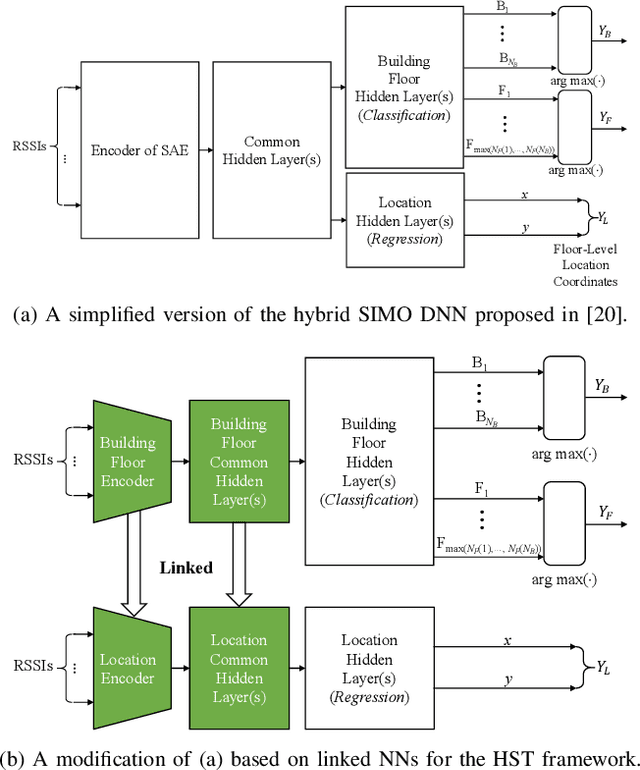
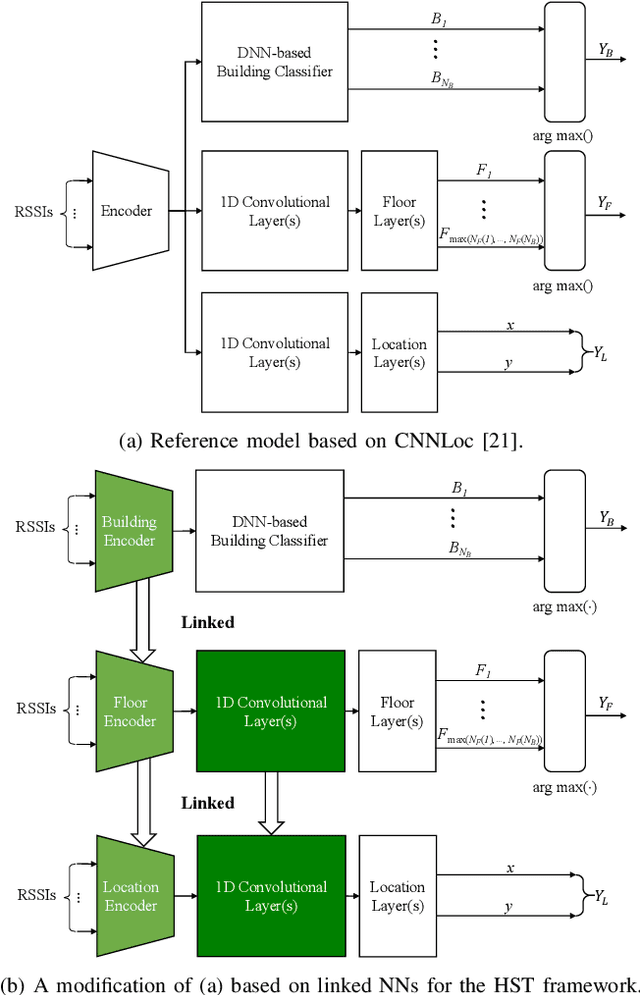
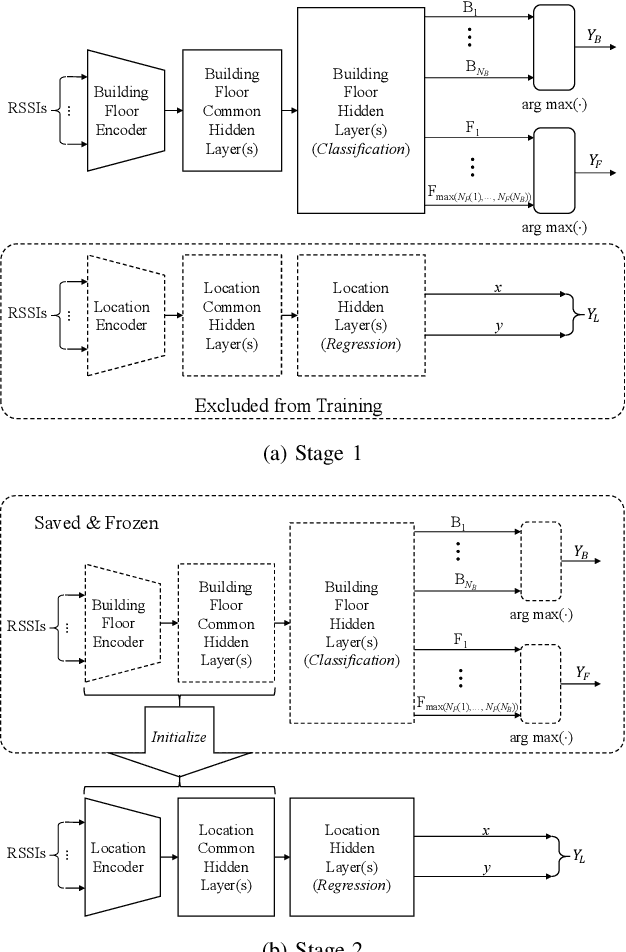
Abstract:In this paper, we present a new solution to the problem of large-scale multi-building and multi-floor indoor localization based on linked neural networks, where each neural network is dedicated to a sub-problem and trained under a hierarchical stage-wise training framework. When the measured data from sensors have a hierarchical representation as in multi-building and multi-floor indoor localization, it is important to exploit the hierarchical nature in data processing to provide a scalable solution. In this regard, the hierarchical stage-wise training framework extends the original stage-wise training framework to the case of multiple linked networks by training a lower-hierarchy network based on the prior knowledge gained from the training of higher-hierarchy networks. The experimental results with the publicly-available UJIIndoorLoc multi-building and multi-floor Wi-Fi RSSI fingerprint database demonstrate that the linked neural networks trained under the proposed hierarchical stage-wise training framework can achieve a three-dimensional localization error of 8.19 m, which, to the best of the authors' knowledge, is the most accurate result ever obtained for neural network-based models trained and evaluated with the full datasets of the UJIIndoorLoc database, and that, when applied to a model based on hierarchical convolutional neural networks, the proposed training framework can also significantly reduce the three-dimensional localization error from 11.78 m to 8.71 m.
Static vs. Dynamic Databases for Indoor Localization based on Wi-Fi Fingerprinting: A Discussion from a Data Perspective
Feb 20, 2024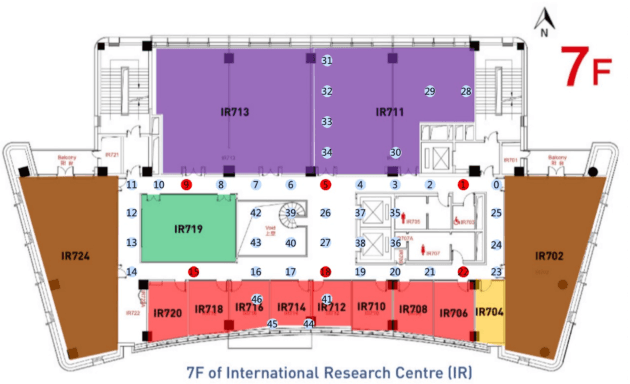
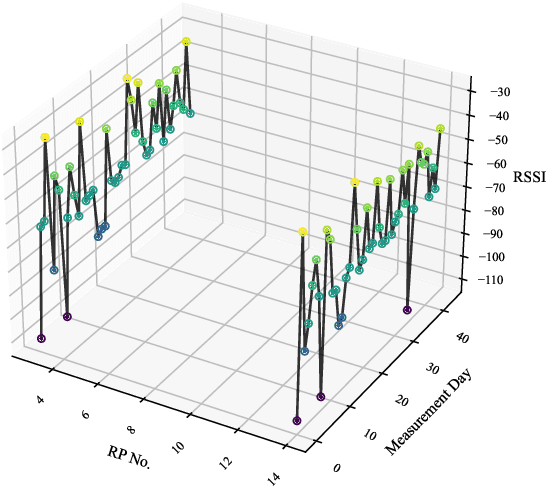
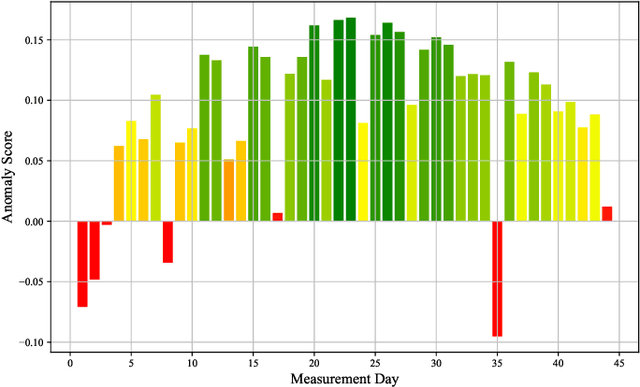
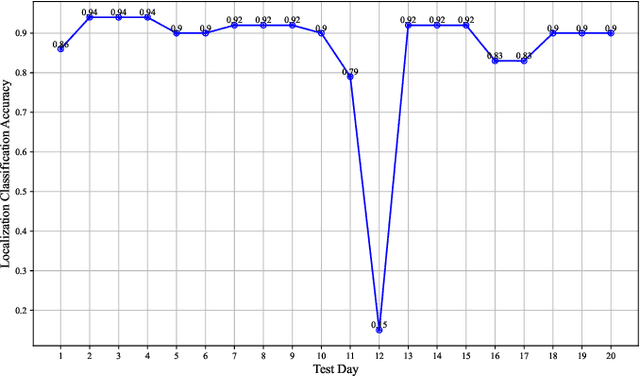
Abstract:Wi-Fi fingerprinting has emerged as the most popular approach to indoor localization. The use of ML algorithms has greatly improved the localization performance of Wi-Fi fingerprinting, but its success depends on the availability of fingerprint databases composed of a large number of RSSIs, the MAC addresses of access points, and the other measurement information. However, most fingerprint databases do not reflect well the time varying nature of electromagnetic interferences in complicated modern indoor environment. This could result in significant changes in statistical characteristics of training/validation and testing datasets, which are often constructed at different times, and even the characteristics of the testing datasets could be different from those of the data submitted by users during the operation of localization systems after their deployment. In this paper, we consider the implications of time-varying Wi-Fi fingerprints on indoor localization from a data-centric point of view and discuss the differences between static and dynamic databases. As a case study, we have constructed a dynamic database covering three floors of the IR building of XJTLU based on RSSI measurements, over 44 days, and investigated the differences between static and dynamic databases in terms of statistical characteristics and localization performance. The analyses based on variance calculations and Isolation Forest show the temporal shifts in RSSIs, which result in a noticeable trend of the increase in the localization error of a Gaussian process regression model with the maximum error of 6.65 m after 14 days of training without model adjustments. The results of the case study with the XJTLU dynamic database clearly demonstrate the limitations of static databases and the importance of the creation and adoption of dynamic databases for future indoor localization research and real-world deployment.
On the Multidimensional Augmentation of Fingerprint Data for Indoor Localization in A Large-Scale Building Complex Based on Multi-Output Gaussian Process
Nov 19, 2022Abstract:Wi-Fi fingerprinting becomes a dominant solution for large-scale indoor localization due to its major advantage of not requiring new infrastructure and dedicated devices. The number and the distribution of Reference Points (RPs) for the measurement of localization fingerprints like RSSI during the offline phase, however, greatly affects the localization accuracy; for instance, the UJIIndoorLoc is known to have the issue of uneven spatial distribution of RPs over buildings and floors. Data augmentation has been proposed as a feasible solution to not only improve the smaller number and the uneven distribution of RPs in the existing fingerprint databases but also reduce the labor and time costs of constructing new fingerprint databases. In this paper, we propose the multidimensional augmentation of fingerprint data for indoor localization in a large-scale building complex based on Multi-Output Gaussian Process (MOGP) and systematically investigate the impact of augmentation ratio as well as MOGP kernel functions and models with their hyperparameters on the performance of indoor localization using the UJIIndoorLoc database and the state-of-the-art neural network indoor localization model based on a hierarchical RNN. The investigation based on experimental results suggests that we can generate synthetic RSSI fingerprint data up to ten times the original data -- i.e., the augmentation ratio of 10 -- through the proposed multidimensional MOGP-based data augmentation without significantly affecting the indoor localization performance compared to that of the original data alone, which extends the spatial coverage of the combined RPs and thereby could improve the localization performance at the locations that are not part of the test dataset.
Multi-Output Gaussian Process-Based Data Augmentation for Multi-Building and Multi-Floor Indoor Localization
Feb 04, 2022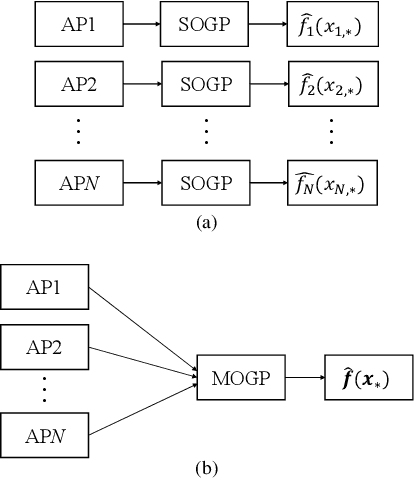
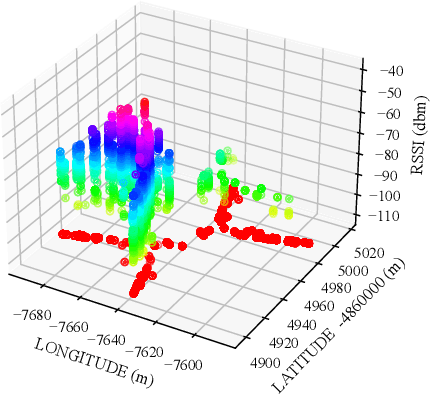
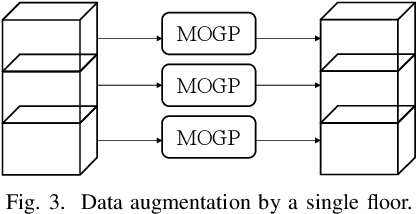
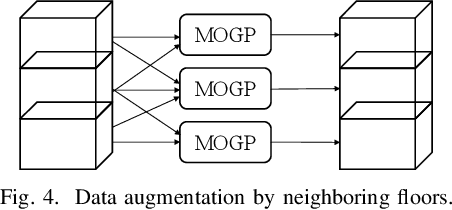
Abstract:Location fingerprinting based on RSSI becomes a mainstream indoor localization technique due to its advantage of not requiring the installation of new infrastructure and the modification of existing devices, especially given the prevalence of Wi-Fi-enabled devices and the ubiquitous Wi-Fi access in modern buildings. The use of AI/ML technologies like DNNs makes location fingerprinting more accurate and reliable, especially for large-scale multi-building and multi-floor indoor localization. The application of DNNs for indoor localization, however, depends on a large amount of preprocessed and deliberately-labeled data for their training. Considering the difficulty of the data collection in an indoor environment, especially under the current epidemic situation of COVID-19, we investigate three different methods of RSSI data augmentation based on Multi-Output Gaussian Process (MOGP), i.e., by a single floor, by neighboring floors, and by a single building; unlike Single-Output Gaussian Process (SOGP), MOGP can take into account the correlation among RSSI observations from multiple Access Points (APs) deployed closely to each other (e.g., APs on the same floor of a building) by collectively handling them. The feasibility of the MOGP-based RSSI data augmentation is demonstrated through experiments based on the state-of-the-art RNN indoor localization model and the UJIIndoorLoc, i.e., the most popular publicly-available multi-building and multi-floor indoor localization database, where the RNN model trained with the UJIIndoorLoc database augmented by using the whole RSSI data of a building in fitting an MOGP model (i.e., by a single building) outperforms the other two augmentation methods as well as the RNN model trained with the original UJIIndoorLoc database, resulting in the mean three-dimensional positioning error of 8.42 m.
Hierarchical Multi-Building And Multi-Floor Indoor Localization Based On Recurrent Neural Networks
Dec 23, 2021



Abstract:There has been an increasing tendency to move from outdoor to indoor lifestyle in modern cities. The emergence of big shopping malls, indoor sports complexes, factories, and warehouses is accelerating this tendency. In such an environment, indoor localization becomes one of the essential services, and the indoor localization systems to be deployed should be scalable enough to cover the expected expansion of those indoor facilities. One of the most economical and practical approaches to indoor localization is Wi-Fi fingerprinting, which exploits the widely-deployed Wi-Fi networks using mobile devices (e.g., smartphones) without any modification of the existing infrastructure. Traditional Wi-Fi fingerprinting schemes rely on complicated data pre/post-processing and time-consuming manual parameter tuning. In this paper, we propose hierarchical multi-building and multi-floor indoor localization based on a recurrent neural network (RNN) using Wi-Fi fingerprinting, eliminating the need of complicated data pre/post-processing and with less parameter tuning. The RNN in the proposed scheme estimates locations in a sequential manner from a general to a specific one (e.g., building->floor->location) in order to exploit the hierarchical nature of the localization in multi-building and multi-floor environments. The experimental results with the UJIIndoorLoc dataset demonstrate that the proposed scheme estimates building and floor with 100% and 95.24% accuracy, respectively, and provides three-dimensional positioning error of 8.62 m, which outperforms existing deep neural network-based schemes.
Hierarchical Auxiliary Learning
Jun 03, 2019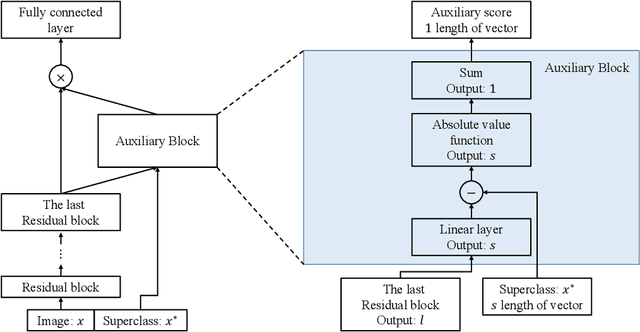
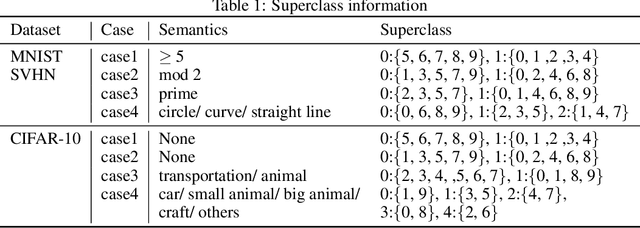


Abstract:Conventional application of convolutional neural networks (CNNs) for image classification and recognition is based on the assumption that all target classes are equal(i.e., no hierarchy) and exclusive of one another (i.e., no overlap). CNN-based image classifiers built on this assumption, therefore, cannot take into account an innate hierarchy among target classes (e.g., cats and dogs in animal image classification) or additional information that can be easily derived from the data (e.g.,numbers larger than five in the recognition of handwritten digits), thereby resulting in scalability issues when the number of target classes is large. Combining two related but slightly different ideas of hierarchical classification and logical learning by auxiliary inputs, we propose a new learning framework called hierarchical auxiliary learning, which not only address the scalability issues with a large number of classes but also could further reduce the classification/recognition errors with a reasonable number of classes. In the hierarchical auxiliary learning, target classes are semantically or non-semantically grouped into superclasses, which turns the original problem of mapping between an image and its target class into a new problem of mapping between a pair of an image and its superclass and the target class. To take the advantage of superclasses, we introduce an auxiliary block into a neural network, which generates auxiliary scores used as additional information for final classification/recognition; in this paper, we add the auxiliary block between the last residual block and the fully-connected output layer of the ResNet. Experimental results demonstrate that the proposed hierarchical auxiliary learning can reduce classification errors up to 0.56, 1.6 and 3.56 percent with MNIST, SVHN and CIFAR-10 datasets, respectively.
On the Transformation of Latent Space in Autoencoders
Jan 24, 2019

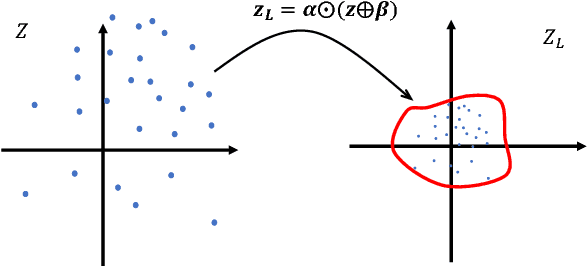

Abstract:Noting the importance of the latent variables in inference and learning, we propose a novel framework for autoencoders based on the homeomorphic transformation of latent variables --- which could reduce the distance between vectors in the transformed space, while preserving the topological properties of the original space --- and investigate the effect of the transformation in both learning generative models and denoising corrupted data. The results of our experiments show that the proposed model can work as both a generative model and a denoising model with improved performance due to the transformation compared to conventional variational and denoising autoencoders.
XJTLUIndoorLoc: A New Fingerprinting Database for Indoor Localization and Trajectory Estimation Based on Wi-Fi RSS and Geomagnetic Field
Oct 17, 2018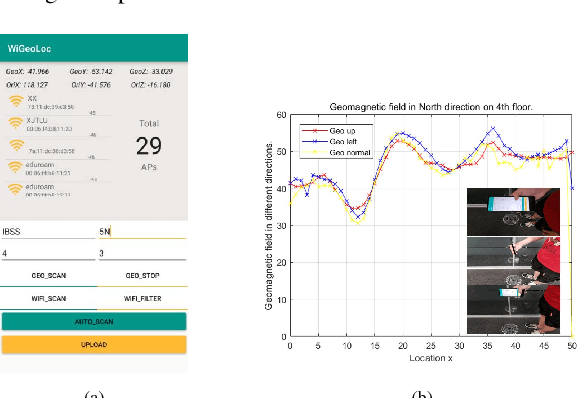
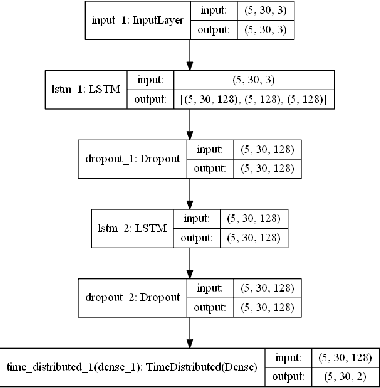
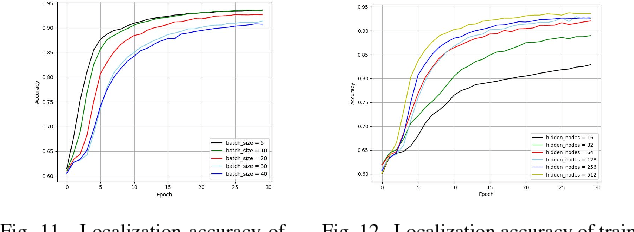
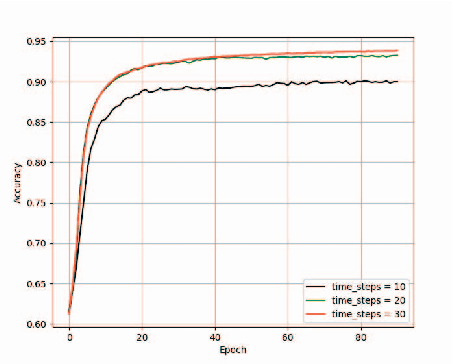
Abstract:In this paper, we present a new location fingerprinting database comprised of Wi-Fi received signal strength (RSS) and geomagnetic field intensity measured with multiple devices at a multi-floor building in Xi'an Jiatong-Liverpool University, Suzhou, China. We also provide preliminary results of localization and trajectory estimation based on convolutional neural network (CNN) and long short-term memory (LSTM) network with this database. For localization, we map RSS data for a reference point to an image-like, two-dimensional array and then apply CNN which is popular in image and video analysis and recognition. For trajectory estimation, we use a modified random way point model to efficiently generate continuous step traces imitating human walking and train a stacked two-layer LSTM network with the generated data to remember the changing pattern of geomagnetic field intensity against (x,y) coordinates. Experimental results demonstrate the usefulness of our new database and the feasibility of the CNN and LSTM-based localization and trajectory estimation with the database.
Hybrid Building/Floor Classification and Location Coordinates Regression Using A Single-Input and Multi-Output Deep Neural Network for Large-Scale Indoor Localization Based on Wi-Fi Fingerprinting
Oct 13, 2018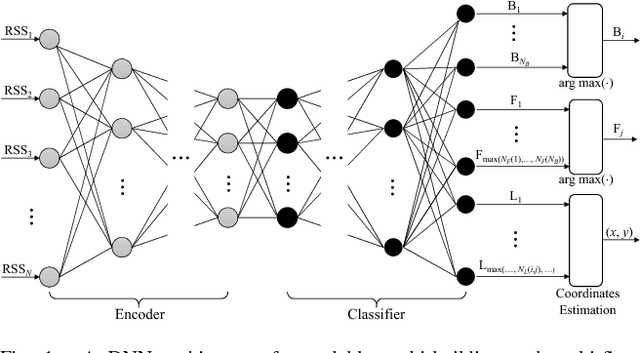



Abstract:In this paper, we propose hybrid building/floor classification and floor-level two-dimensional location coordinates regression using a single-input and multi-output (SIMO) deep neural network (DNN) for large-scale indoor localization based on Wi-Fi fingerprinting. The proposed scheme exploits the different nature of the estimation of building/floor and floor-level location coordinates and uses a different estimation framework for each task with a dedicated output and hidden layers enabled by SIMO DNN architecture. We carry out preliminary evaluation of the performance of the hybrid floor classification and floor-level two-dimensional location coordinates regression using new Wi-Fi crowdsourced fingerprinting datasets provided by Tampere University of Technology (TUT), Finland, covering a single building with five floors. Experimental results demonstrate that the proposed SIMO-DNN-based hybrid classification/regression scheme outperforms existing schemes in terms of both floor detection rate and mean positioning errors.
 Add to Chrome
Add to Chrome Add to Firefox
Add to Firefox Add to Edge
Add to Edge